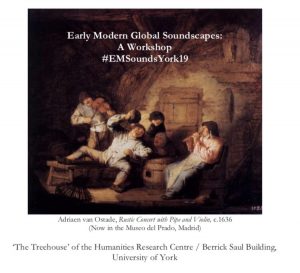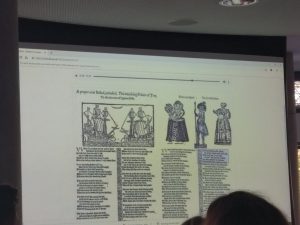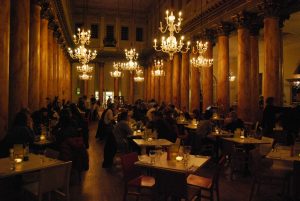by Hannah Rodger (University of York)
On 25-26 January 2019, academics and scholars from across the world met at the University of York to take part in a workshop on ‘Early Modern Global Soundscapes’. The main aim of this workshop was to examine how sounds shaped the lives of individuals and their communities in the early modern world. Through bringing together researchers from Music, History, History of Art, English, Theatre Film and Television, and Ethnomusicology, this workshop aimed to address several, as yet unresolved, questions concerning historic sounds; especially the tension between the particular and the universal.
This workshop contained four panels which consisted of short presented papers and chaired discussions. Within these, it was debated whether there were any commonalities between soundscapes, or whether all soundscapes are unique. Central issues such as what a soundscape actually is, and whether definitions are dependent on disciplinary perspectives, were also considered. These discussions ultimately enabled an examination of whether there is a collective way that all scholars can, and even should, conceptualise soundscapes.
The first panel, which opened the workshop, concentrated on ‘sounds from England and Germany’. The first paper was on ballads in the soundscape: six consecutive notes, and was presented by Christopher Marsh from Queen’s University, Belfast’s History department. This paper drew on Marsh’s current research where he is investigating English Broadside ballads of the sixteenth century in order to identify 100 hit ballads of the period, without print rolls or receipts. The aim of this project is to re-establish ballads as musical and pictorial sources, not just as texts. Several key issues which emerged from Marsh’s presentation were the constant interaction of sound and silence, and how sounds travel between the aural/oral, literature, and contemporary cultures. Marsh’s research is being collated onto a project website where musical recordings of these ballads, commissioned from the acclaimed Carnival Band, can be heard.
The second paper of his panel was presented by Alexander Fisher from the Music department at the University of British Columbia, Vancouver. Fisher’s paper concentrated on soundscapes and confessional spaces in early modern Germany. Fisher discussed how spaces are organised and perceived and how, when spaces are visually remodelled, individuals do not necessarily change what sounds they produce. Fisher firstly questioned how auditory spaces can both enhance and come into conflict with visual spaces. This discussion particularly related to people’s religious identities within Catholic spaces in late-sixteenth-, and early-seventeenth-century Munich. The potential strengths and limitations of acoustical measurements were acknowledged and, therefore, Fisher impressed that modern day scholars need to redefine what a soundscape is. Linking in with Marsh’s paper, Fisher emphasised that sound should not be perceived as objective; rather it is necessary to examine how we process sound ‘between our ears’. He consequently concluded that the idea of reconstructing a soundscape is highly problematic. It can even seem unrealistic, due to how subjectively people listen, and the challenges between aural/oral and visual landscapes.
This panel was followed by a discussion led by Iain Fenlon from the Music department at King’s College, Cambridge. Fenlon proffered a polemical response in which he stated that it is necessary to be aware that much evidence of sound and music is exceptional, rather than the rule. Following on from this a discussion emerged with the audience, on the subject of the potential anachronisms of artificially separating the senses (i.e. by focusing exclusively on ‘hearing’). Marsh responded by agreeing that producing a hierarchy of sight and sound is often a distraction within soundscape studies, suggesting that hearing is also culturally determined. Fenlon also reminded the audience that performances often contain visual and haptic elements, with singers using gesture and expression. Fisher closed this panel by reiterating, in support of this workshop’s aims, that we should not just utilise the the term soundscape without carefully interrogating it first.
The second panel of this workshop took a slightly different format as it featured a series of ten, three-minute quick-fire presentations from early career soundscape researchers. This session was chaired by Deborah Howard from the History of Art department of St John’s College, Cambridge.
From Music, the audience heard about the relationship between sound, conflict, and punishment during the long English reformation (Eleanor Hedger, University of Birmingham), and how it is necessary to re-examine the presumed elaborate musical practices of the English seventeenth-century Laudians (Hannah Rodger, University of York).
From History, presentations ranged from the cries and noises of street sellers in early modern London, and the creation of stereotypes through sound (Charlie Taverner, University of London), to parochial religious soundscapes relating to the control, reform and restriction of sound in Bristol and Gloucester (Chris Barnes, University of Birmingham), and to the effect of control and the penal laws on Irish soundscapes (Maura Valenti, Trinity College, Oxford).
From English, presentations focused on the early modern stage in relation to how sound effects were consciously used by playwrights to enhance the theatrical experience (Laura Wright, University College, Oxford), on how the sound of a “drone” was connected to negative ideas about labour and productivity (Robert Stearn, Birkbeck, University of London), and the ways in which we might investigate and recapture religious echoes, particularly in how sermons were repeated or used in the domestic sphere (Cat Evans, University of Sheffield).
Additionally, from the Harvard University Centre for Renaissance Studies, insights into the acoustic politics of the confraternity of Bergano and how the sonic reach of the confraternity passed over its boundaries into the city itself were introduced (Emanuela Vai, Villa I Tatti, Florence). Finally, research into the small community of Italian merchants living in sixteenth-century London and how this community changed with the sounds and architecture of London was presented (Tom Roberts, TIDE project, University of Liverpool).
Questions from the audience were consequently posed on how these early career researchers were coping with research outputs which are largely confined to the written page, and ultimately, why these researchers believe that their work into soundscapes is important.
The second day of this workshop began with the third panel which featured two ‘personal papers’ on ‘voices, books and music’s effects’. This panel was opened by Jennifer Richards from the University of Newcastle’s English department, who spoke about voices, texts and books. Richards began by questioning how research into soundscapes could be developed to extend beyond visual dependency. However, she impressed that it is impossible to properly listen to a soundscape without understanding the physical voice and its training. To illustrate her points, Richards mentioned the Virtual Paul’s Cross project, where sermons by John Donne have been recreated using original pronunciation. The main concerns of this project relate to acoustics and what techniques were then recommended when reading loudly and distinctly. Richards explained that during the sixteenth and seventeenth centuries, vocal training was provided to boys from a young age, and they were thus taught to match their vocal qualities to a specific situation. Recitations therefore required more than just ‘a good pair of lungs’. Instead, it was necessary to consider vocal qualities, control, understanding, tone, pitch, rhythm, and timbre. Richards concluded by stating that this research is highly important as a central understanding of the physical voice will change soundscapes and how genres can be created. To Richards, written materials are consequently not just objects, but are full of voices waiting to be animated.
The second paper in this panel was given by Penelope Gouk from the University of Manchester’s History department. Gouk, drawing on her own research, discussed where music fits into soundscapes and its associations with the cosmic harmony of the world. She further impressed on the audience that music should not be relied upon to be a harmonising experience. It is instead also necessary to examine cognitive, emotional and scientific relationships with music. Through this process of refinement, Gouk demonstrated how music appears to be able to build individual and group social relationships. Consequently, through examining both vocal and instrumental music, and recreating historically informed practices, Gouk explained how changes in musical practices and the relationship between music and the physical, intellectual and spiritual worlds, can change the music itself. Gouk consequently summarised that it is essential to conduct interdisciplinary soundscape studies to unearth how changes in musical practice have given birth to new models of thinking and feeling.
These papers were followed by a discussion session led by Rachel Willie from Liverpool John Moores University’s English department. The audience and speakers consequently discussed how modern scholars could recreate soundscapes. The importance of considering how performances could mean different things to each individual listener, and how the meaning could be altered depending on the utilised performance techniques, was impressed. A discussion ensued on what is meant by ‘voice’, regarding how aural/oral studies relate to the different senses, and even how these soundscapes would have been interpreted by deaf people.
The final panel of this workshop was on ‘hearing and listening in England and India’. This was opened by William Tullet from Anglia Ruskin University’s History department. Tullet described himself as a sensory historian and his paper concentrated on the academic value of ‘hearing the past’ in soundscape recreations. Tullet described how during sonic event recreations, when sounds are taken outside of their original context, some performance aspects are lost. In particular, Tullet accounted how researchers are all too keen to control the past by removing uncomfortable aspects, such as performance controversies, which were important to the original listeners. He further discussed the use of the ear as a contemporary recording device, for both sound and textual archives, which could enable observers to listen and hear these soundscapes. Tullet consequently suggested that recreations are important impact events but that they often seem separate from researchers’ usual academic work. However, more considerations into the individual ways that people hear and interpret music, and the different locations where the sounds are mobilised from, should be made. Subsequently, Tullet encouraged the formation of interdisciplinary collaborations between acoustic engineers, historians and other experts.
As the last presentation of this workshop, an ethnomusicology paper on ‘listening in early modern India: sound and experience in classical Hindi’ was given by Richard Williams from SOAS, University of London. Williams is investigating how to listen to images from seventeenth- to nineteenth-century North India. He presented the audience with paintings of the Rajasthan court which often feature representations of musicians who are only visible to the paintings’ observers, not to the depicted nobles. Williams discussed how he is studying rāga descriptions and depictions to decide whether it is necessary to decolonise or provincialise models of sound to construct a Mogul ontology of sound. These rāgas were the building blocks of improvisation and composition in Indian music. Through studying various treatise on aesthetics and poetic history, Williams discovered that a new intellectual context of rāga descriptions could be formed. He consequently described how, informed by poetics and a courtly fascination with feeling (rasa), elite connoisseurs (rasika) were trained to experience music through embodied perception and listen for a recollected vision within the music. Williams also identified a further desire amongst patrons to be seen as living embodies of rāgas or literary male archetypes. Williams subsequently impressed the importance of listening to these rāga images, to reveal that these ‘rāgas were understood to possess a sonic power over matter, including the physiology of the human body, and were therefore literally instrumental to self-cultivation.’
This panel was then followed by a discussion with the audience, led by Simon Ditchfield from the University of York’s History department, into the visuality and temporality of sound. In relation to the visuality of sound, the importance of listening and seeing sound was emphasised, and ideas concerning problems with the temporality of sound within digital recreations were then debated. The audience was reminded that, when listening to music, normal time can seem to be suspended. The workshop attendees were also asked to consider that some music was composed, more because it held important and appropriate meanings to the composer and culture of the time, and was not necessarily intended to be heard. Consequently, the importance of situating music within contemporary spaces, whilst ensuring that the authentic audience, and individual perceptions of sound are considered, was impressed.
The final session took the form of an informal roundtable discussion to summarise the ideas which had emerged with this workshop and how soundscape studies should proceed. This was led by staff from the University of York, Lidia Alvarez Morales (TFTV), Helen Hills (History of Art), Mark Jenner, (History), Mariana Lopez (TFTV) and Emilie Murphy (History).
The use of computer modelling for soundscape recreations was discussed first. Computer modelling was seen to be important to ensure that soundscape research has a more wide-ranging impact. It was even debated whether it might be necessary to add in more commercial, even imaginary aspects, to draw audiences in and make research more marketable to funding agencies. The problems between making recreations evocative and historically accurate were thus presented. It was also emphasised that, in the past, researchers have placed too great a focus on the final product, rather than the creation process.
Building on this workshop’s previous discussions, the importance of considering the authentic audience and how individual listeners could have, and do, hear and attach meaning to sounds, was highlighted. The audience was also reminded to reflect on the interrelationship of the senses.
Richard Williams also asked the assembled scholars to consider the aims of this workshop to address the ‘global’, especially as his paper was the only one to study soundscapes outside of Europe. He accentuated the radical differences between these sound worlds, and therefore encouraged the audience to further contemplate how such studies could be more cohesively and productively linked together.
It was concluded that far more interdisciplinary studies are needed to properly research and recreate soundscapes. Further, it was impressed that researchers need to stop using the word ‘soundscape’ as a shorthand term and should instead be critically engaging with it. Ultimately, this was the aim and embodiment of this workshop; to bring researchers from across the disciplines and the world together, to critically analyse and interrogate the word soundscape, and to discover new ways in which researchers could work together to further early modern soundscape studies.
Indeed, this is one of the main aims of an AHRC-funded international research network that was also announced at this workshop on ‘Soundscapes in the Early Modern World’. The network, with events from March 2019 to July 2020, is led by Rachel Willie (LJMU) and Emilie Murphy (York). The network will bring scholars from multiple disciplines together to ask how we might develop new approaches to hearing the sounds of the early modern world, reflect on how we engage with historical soundscapes, and consider the multifaceted relationship between meaning and hearing. For more information on the events and how to participate please see the project website.
The organisers would like to thank all the speakers, chairs and participants for ensuring that the workshop and its resulting discussions were so stimulating and dynamic. We would also like to thank our sponsors, the Past and Present Society, the Centre for Renaissance and Early Modern Studies (York) and the Society for Renaissance Studies for funding the workshop, and especially for providing us with the means to fund the bursaries that supported the attendance of a large number of PhD students and early career scholars.
Online discussion around this event has been compiled and can be read here.
Past & Present was pleased to support this event and supports other events like it. Applications for event funding are welcomed from scholars working in the field of historical studies at all stages in their careers.




